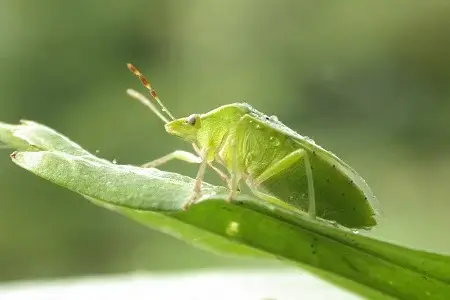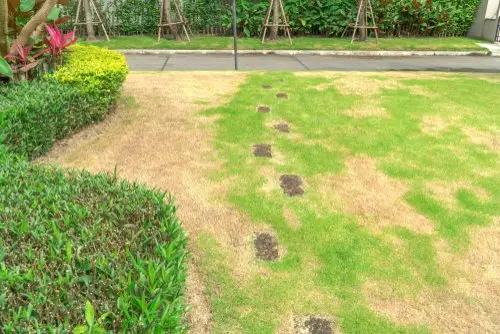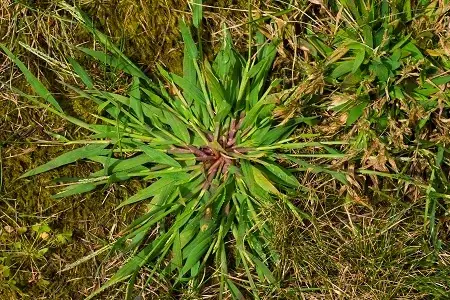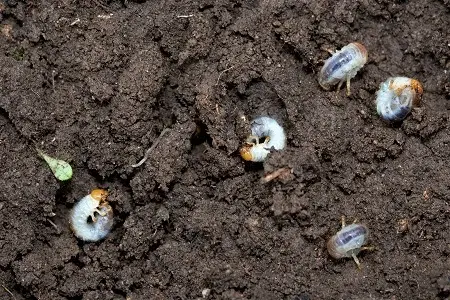How to identify and Treat Lawn Pests and weeds

Explore the world of your lawn, a peaceful green canvas that often faces the threat of pests hiding under the blades. This journey will reveal the drama of lawn pests and equip you with the knowledge to detect, solve, and defeat them. Get ready to become the Sherlock Holmes of your green haven, and watch as your lawn transforms from a potential damage zone into a thriving haven of beauty. Let’s embark on a journey towards a healthier and greener lawn.
Importance of Identifying and Treating Lawn Pests
In this battle against the green menace, knowledge is your sharpest weapon. Understanding the significance of identifying and treating lawn pests transforms you from a mere spectator to the vigilant guardian of your green kingdom.
- Early Intervention Magic: Swift identification of pest infestations allows timely intervention, preventing minor issues from evolving into full-blown turf disasters.
- Holistic Lawn Well-being: The health of your lawn is intricately linked to your ability to recognize and treat pests effectively. A well-tended lawn is a resilient fortress against the green invaders.
How to Spot Lawn Pest Infestations
Unravelling the mystery of common lawn pests begins with keen observation. Keep a vigilant eye on your green canvas, and let the signs and symptoms speak to you:
- Brown Patches in Disguise: Grubs may be lurking beneath, causing damage to the grassroots. Lift the turf; if it easily peels away, grubs might be the masked culprits.
- Yellowing Hues of Chinch Bug Mischief: When sunny spots turn yellow, chinch bugs might be at play. Get up close; you might catch nymphs scurrying near the base of grass blades.
- Silk-Lined Tunnels: Webworm Wonderland: Sod webworms leave behind a distinctive calling card—silken tunnels near the soil surface. If your grass wears silk, webworms may be orchestrating the show.
- Ragged Blades, Courtesy of Armyworms: Witnessing grass blades with a jagged appearance? Check during the early morning or evening; armyworms might be staging their munching performance.
- Severed Stems by Cutworm Intruders: Young plants showing signs of sudden beheading? Check for cutworms at night, the sneaky culprits with a penchant for nocturnal snacking.
Take Action: Act swiftly upon spotting these symptoms. Your lawn is a stage; with the right cues, you can direct a plot twist ending in pest control triumph.
Spotlight on Weeds: Controlling Unwanted Intruders 
Weeds—nature’s party crashers—threaten the harmony of your green haven. But fear not, for you hold the spotlight and the power to control these weeds:
- Dandelions: The Persistent Guests: Spotting yellow blooms of dandelions? Grab a weeder and get to the root of the matter. Eliminate them before they spread their airborne invitations.
- Crabgrass: The Uninvited Intruder: Crabgrass gatecrashing your turf? Deploy pre-emergent herbicides in spring to prevent their unwelcome presence. Your lawn deserves a crabgrass-free party.
- Clover: The Green Party Crasher: Clover crashing your green party? Adjust your mower height to favour grass over clover. In cases of rebellion, herbicides can be your firm bouncers.
- Thistles: The Prickly Intruders: Prickly thistles making an unwelcome entrance? Embrace hand-pulling for small infestations or wield herbicides for larger thistle gatherings.
- Quackgrass: The Sneaky Invader: Quackgrass trying to infiltrate? Outsmart it with diligent hand-pulling and spot treatments of herbicides. Show quackgrass that your lawn is a fortress, not an invasion zone.
Take Control: Weeds may try to dance in your lawn, but you can set the rhythm with your active intervention. Weed out the unwanted guests, and let your lawn’s beauty take center stage.
Most Common Lawn Pests 
Let’s delve deeper into the lifecycle, symptoms, and solutions for each of the five common lawn pests:
Grubs (Beetle Larvae):
- Lifecycle:Adult beetles lay eggs in the soil during late spring to early summer. The eggs hatch into C-shaped larvae, grubs, which feed on grassroots. In late summer or fall, grubs pupate and transform into adult beetles.
- Symptoms:Brown patches that easily lift, revealing severed grassroots. Increased animal activity, such as birds or raccoons, digging in the lawn.
- Solutions:Apply beneficial nematodes in late summer or early fall. Use grub control products containing insecticides like imidacloprid or chlorantraniliprole. Water deeply to deter egg-laying.
Chinch Bugs:
- Lifecycle:Chinch bugs undergo incomplete metamorphosis, progressing from eggs to nymphs to adults. Adult chinch bugs have distinct black bodies with white wings.
- Symptoms:Yellowing grass, progressing to brown patches, especially in sunny areas. Presence of red or orange nymphs near the base of grass blades.
- Solutions:Use insecticidal soaps or neem oil to control nymphs. Maintain a well-hydrated lawn to discourage chinch bugs, which thrive in dry conditions.
Sod Webworms:
- Lifecycle:Adult moths lay eggs on grass blades in the evening. Larvae, or webworms, spin silken webs as they feed on grass blades at night. They pupate in the soil before emerging as moths.
- Symptoms:Irregular patches of brown, closely cropped grass with silk-lined tunnels near the soil surface.
- Solutions:Apply insecticidal nematodes or chemical insecticides containing bifenthrin or spinosad. Encourage natural predators like predatory wasps.
Armyworms:
- Lifecycle:Adult moths lay eggs on grass blades. The larvae, resembling tiny caterpillars, feed on grass blades and soil debris. They pupate in the soil before transforming into moths.
- Symptoms:Grass blades with a ragged appearance, often visible in the early morning or evening. Severe defoliation in a short period.
- Solutions:Apply insecticides containing carbaryl or spinosad when larvae are actively feeding. Introduce natural predators such as birds, parasitic wasps, or beneficial nematodes.
Cutworms:
- Lifecycle:Cutworms are the larvae of certain moth species. Moths lay eggs on grass blades, and the larvae feed on young plants and grass blades at night. They pupate in the soil before becoming moths.
- Symptoms:Cut or damaged stems near the soil surface, especially on young plants. Young plants may appear severed at the base.
- Solutions:Implement physical barriers like cardboard collars around young plants. Use biological controls such as Bacillus thuringiensis (Bt) or insecticidal soaps. Handpick and remove cutworms during nighttime inspections.
By understanding the lifecycles and behaviour of these lawn pests, you can implement targeted solutions to keep your lawn healthy and green. Regular monitoring and prompt action are essential to effective pest management.
Controlling Effective Lawn Pests 
Maintaining a lush, green lawn is a delight, but it often comes with combating pesky invaders. Fear not! Here’s your go-to guide on how to take charge and effectively control lawn pests, ensuring your outdoor space remains a thriving haven for relaxation and enjoyment.
Early Detection
- Active Approach: Regularly inspect your lawn for signs of pests. Look for brown patches, wilting grass, or unusual behaviour in your green oasis.
- Swift Action: Act promptly upon detecting signs of infestation. Early intervention can prevent widespread damage and keep your lawn resilient.
Beneficial Nematodes
- Biocontrol Marvels: Introduce beneficial nematodes to your lawn. These microscopic organisms seek out and destroy pests like grubs, providing a natural and eco-friendly solution.
- Effective Application: Apply nematodes during the late summer or early fall when pests are in their vulnerable larval stage.
Neem Oil Magic 
- Organic Defense: Harness the power of neem oil, a natural insecticide. Neem disrupts the lifecycle of pests like chinch bugs, offering a safe and effective way to protect your lawn.
- Simple Application: Mix neem oil with water and apply it to affected areas. Repeat as needed to maintain control.
Insecticidal Soaps
- Targeted Action: Employ insecticidal soaps for a targeted attack on pests like sod webworms. These soaps disrupt the protective coating of insects, leading to their demise.
- User-Friendly: Spray the affected areas with insecticidal soap, ensuring thorough coverage. Repeat applications if necessary.
Natural Predators
- Feathered Friends: Attract birds to your lawn, as they are natural predators of pests like armyworms. Bird feeders and baths can create a welcoming environment for these helpful allies.
- Encourage Biodiversity: Foster a habitat that supports beneficial insects such as ladybugs, spiders, and predatory wasps. They play a crucial role in maintaining a balanced ecosystem.
Precision in Pest Management
- Choose Wisely: Opt for insecticides specific to the pests you’re dealing with. For example, use Bt (Bacillus thuringiensis) for controlling cutworms.
- Follow Instructions: Apply insecticides according to label instructions. Avoid overuse, and prioritize environmentally friendly options.
Lawn Maintenance Practices
- Regular Mowing: Keep your lawn well-manicured through regular mowing. This enhances its aesthetic appeal and reduces hiding spots for pests.
- Adequate Watering: Maintain proper watering practices to discourage certain pests. Well-hydrated lawns are less attractive to chinch bugs and other moisture-sensitive invaders.
The Bottom Line
As the final curtain falls on our expedition with EcoIndoorGardening through the realms of lawn pests, envision yourself as the vigilant guardian of your green kingdom. With knowledge as your ally, you’ve deciphered the cryptic signs, identified the intruders, and orchestrated a symphony of treatments to safeguard your turf. Bid farewell to the green menace, and watch as your lawn emerges unscathed and transformed into a resilient haven of lush beauty. The saga continues, and with your newfound expertise, your green kingdom stands as a testament to the triumph of the guardian over the hidden threats that once lurked beneath the surface.










